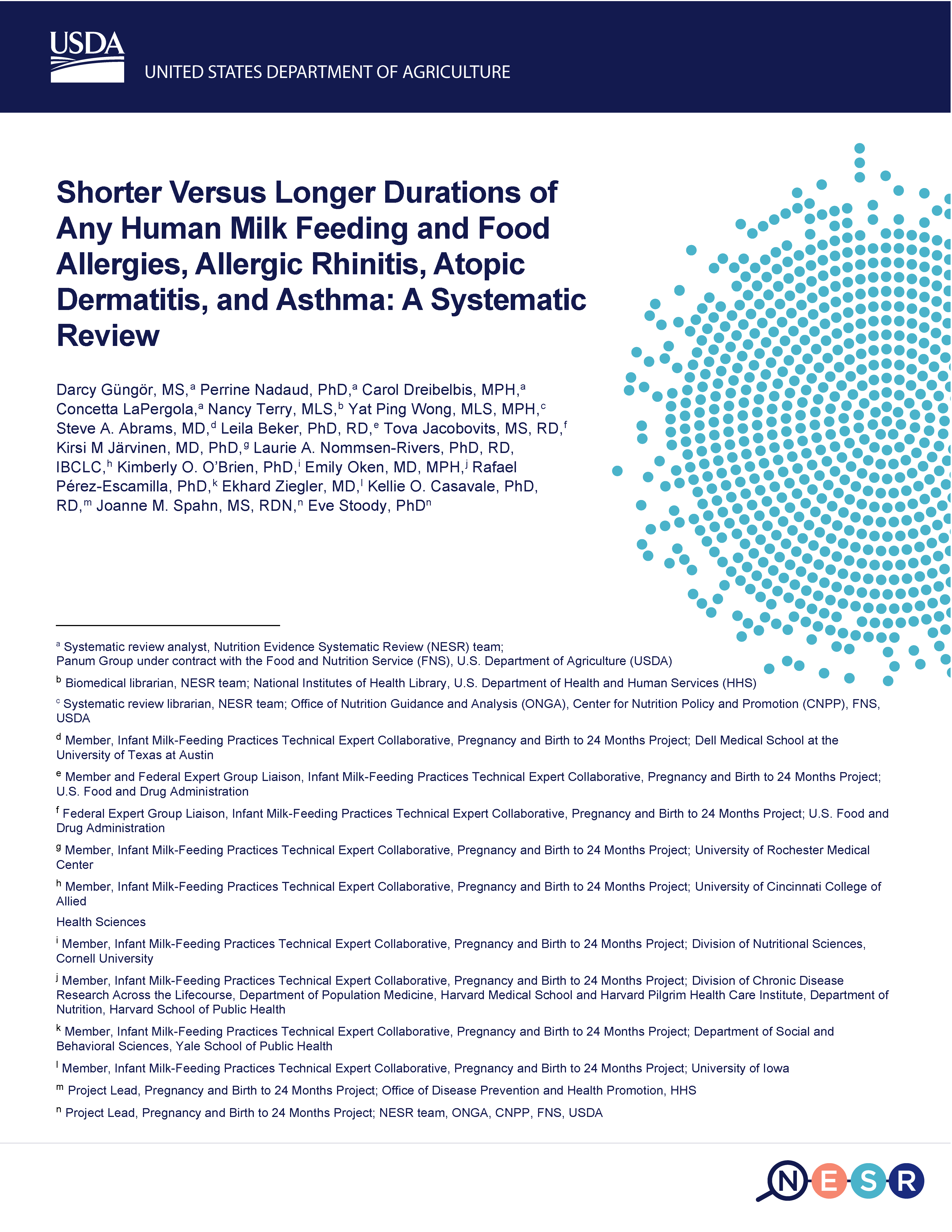

Conclusion Statement
Moderate evidence mostly from observational studies suggests that, among infants fed human milk, shorter versus longer durations of any human milk feeding are associated with higher risk of asthma in childhood and adolescence.
Limited evidence does not suggest a relationship between the duration of any human milk feeding and allergic rhinitis or atopic dermatitis in childhood.
Evidence about the relationship between shorter versus longer durations of any human milk feeding and atopic dermatitis from birth to 24 months is inconclusive, and there is insufficient evidence to determine the relationship of shorter versus longer durations of any human milk feeding with food allergies throughout the lifespan; allergic rhinitis from birth to 24 months, in adolescence, or in adulthood; asthma in adulthood; and atopic dermatitis in adolescence or in adulthood.
Grade: Moderate – asthma in childhood and adolescence; Limited – allergic rhinitis and atopic dermatitis in childhood; Grade Not Assignable – food allergies throughout the lifespan, allergic rhinitis and atopic dermatitis outside of childhood, asthma in adulthood.
Plain Language Summary
What is the question?
- The question is: What is the relationship between shorter versus longer durations of any human milk feeding and food allergies, allergic rhinitis, atopic dermatitis, and asthma?
What is the answer to the question?
- Moderate evidence mostly from observational studies suggests that, among infants fed human milk, shorter versus longer durations of any human milk feeding are associated with higher risk of asthma in childhood and adolescence.
Limited evidence does not suggest a relationship between the duration of any human milk feeding and allergic rhinitis or atopic dermatitis in childhood.
Evidence about the relationship between shorter versus longer durations of any human milk feeding and atopic dermatitis from birth to 24 months is inconclusive, and there is insufficient evidence to determine the relationship of shorter versus longer durations of any human milk feeding with food allergies throughout the lifespan; allergic rhinitis from birth to 24 months, in adolescence, or in adulthood; asthma in adulthood; and atopic dermatitis in adolescence or in adulthood.
Why was this question asked?
- This important public health question was identified and prioritized as part of the U.S. Department of Agriculture and Department of Health and Human Services Pregnancy and Birth to 24 Months Project.
How was this question answered?
- A team of Nutrition Evidence Systematic Review staff conducted a systematic review in collaboration with a group of experts called a Technical Expert Collaborative.
What is the population of interest?
- The population of interest was generally healthy infants and toddlers (ages 0-24 months) who were in studies examining food allergies, allergic rhinitis, and atopic dermatitis throughout the lifespan and asthma from childhood through adulthood (ages 2 years and up).
What evidence was found?
- This review includes 35 articles.
- These articles compared infants fed human milk for shorter durations with infants fed human milk for longer durations. The infants could be fed any amount of human milk.
- These articles examined available evidence related to food allergies, allergic rhinitis, atopic dermatitis, and asthma.
- Most of the evidence examined allergic rhinitis, atopic dermatitis, and asthma through childhood.
- Children and adolescents who were fed human milk for shorter durations may have higher risk of asthma than children and adolescents who were fed human milk for longer durations.
- Children who were fed human milk for shorter durations and children who were fed human milk for longer durations do not seem to have different risk of allergic rhinitis or atopic dermatitis.
- There are limitations in the evidence as follows:
- There was not a lot of evidence about food allergies.
- There was not a lot of evidence in adolescents or adults.
- Some studies did not use strong methods to collect infant feeding data or measure outcomes.
- It is possible for factors other than infant feeding to impact the observed outcomes, and these factors were addressed differently by different studies.
- Some of the articles studied groups of children that may have been too small to detect whether there is a relationship between shorter versus longer durations of any human milk feeding and the outcomes.
- Atopic disease may impact the duration of any human milk feeding, because parents may decide, or receive medical advice, to continue or discontinue feeding human milk based on infants’ symptoms or because of a history of atopic disease in parents or older siblings.
How up-to-date is this systematic review?
- This review includes literature from 01/1980 to 03/2016.
Where do I find more information...? |
|
Technical Abstract
Background
- This systematic review was conducted as part of the U.S. Department of Agriculture and Department of Health and Human Services Pregnancy and Birth to 24 Months Project.
- The goal of this systematic review was to examine the following question: What is the relationship between shorter versus longer durations of any human milk feeding and food allergies, allergic rhinitis, atopic dermatitis, and asthma?
- This systematic review examines comparisons of infants who were fed human milk for shorter durations with infants who were fed human milk for longer durations. Human milk feeding was defined as feeding human milk alone or in combination with infant formula and/or complementary foods or beverages such as cow’s milk. Human milk was defined as mother’s own milk provided at the breast (i.e., nursing) or expressed and fed fresh or after refrigeration or freezing. Donor milk (e.g., banked milk) was not examined in this review.
- This systematic review examines available evidence related to food allergies, allergic rhinitis, and atopic dermatitis from birth through adulthood and asthma from childhood through adulthood (outcomes prior to childhood may represent transient recurrent wheeze).
Conclusion Statement and Grade
- Moderate evidence mostly from observational studies suggests that, among infants fed human milk, shorter versus longer durations of any human milk feeding are associated with higher risk of asthma in childhood and adolescence.
Limited evidence does not suggest a relationship between the duration of any human milk feeding and allergic rhinitis or atopic dermatitis in childhood.
Evidence about the relationship between shorter versus longer durations of any human milk feeding and atopic dermatitis from birth to 24 months is inconclusive, and there is insufficient evidence to determine the relationship of shorter versus longer durations of any human milk feeding with food allergies throughout the lifespan; allergic rhinitis from birth to 24 months, in adolescence, or in adulthood; asthma in adulthood; and atopic dermatitis in adolescence or in adulthood.
Grade: Moderate – asthma in childhood and adolescence; Limited – allergic rhinitis and atopic dermatitis in childhood; Grade Not Assignable – food allergies throughout the lifespan, allergic rhinitis and atopic dermatitis outside of childhood, asthma in adulthood
Methods
- The systematic review was conducted by a team of staff from the Nutrition Evidence Systematic Review in collaboration with a Technical Expert Collaborative.
- A single literature search was conducted to identify literature for several related systematic reviews that examined infant milk-feeding practices and different outcomes. The search was conducted in CINAHL, Cochrane, Embase, and PubMed, and used a search date range of January 1980 to March 2016. A manual search was done to identify articles that may not have been included in the electronic databases searched.
- Articles were screened independently by 2 NESR analysts to determine which articles met predetermined criteria for inclusion.
- Data from each included article were extracted, risks of bias were assessed, and both were checked for accuracy.
- The body of evidence was qualitatively synthesized, a conclusion statement was developed, and the strength of the evidence (grade) was assessed using pre-established criteria including evaluation of the internal validity/risk of bias, adequacy, consistency, impact, and generalizability of available evidence.
Summary of Evidence
- Thirty-five articles met the inclusion criteria for this systematic review, including 3 with evidence about food allergies, 7 with evidence about allergic rhinitis, 15 with evidence about atopic dermatitis, and 23 with evidence about asthma. Almost all of the evidence was from observational studies.
- Evidence about the association between shorter versus longer durations of any human milk feeding and higher risk of asthma in childhood and adolescence was moderate. Across the 20 independent studies (21 articles), 8 found statistically significant associations and, with 1 exception, they showed that shorter durations of any human milk feeding was associated with higher risk. The majority of nonsignificant associations were also consistent in suggesting higher risk of asthma in childhood and adolescence with shorter durations of any human milk feeding, and some of the inconsistency in statistical significance may be explained by insufficient statistical power. The ability to draw stronger conclusions was primarily limited by the limited statistical power in some studies and concerns about reverse causality and internal validity, such as the potential for confounding in a body of evidence primarily made up of observational studies.
- Evidence about the lack of an association between shorter versus longer durations of any human milk feeding and allergic rhinitis and atopic dermatitis in childhood was limited. Across the 5 independent studies (6 articles) that examined allergic rhinitis in children, the only significant association was from a subsample analysis of African-American children, and there were no comparable analyses with which to compare the result. Likewise, across the 8 independent studies (9 articles) that examined atopic dermatitis in children, the only significant associations were reported by a study with risk of multiple comparison bias. The ability to draw stronger conclusions was primarily limited by the small number of studies, limited statistical power in some studies, concerns with generalizability of the samples to diverse U.S. populations, and concern about the potential for confounding.
- Evidence about atopic dermatitis from birth to 24 months was inconclusive. Across 8 studies, the associations were inconsistent in direction. There was also concern about the specificity of diagnosing atopic dermatitis in this age group.
- Evidence related to food allergies throughout the lifespan, and outcomes beyond childhood, in general, was scant.
Where do I find more information...? |
|
Full Systematic Review

Download Now
Suggested citation: Güngör D, Nadaud P, Dreibelbis C, LaPergola C, Terry N, Wong YP, Abrams SA, Beker L, Jacobovits T, Järvinen KM, Nommsen-Rivers LA, O’Brien KO, Oken E, Pérez-Escamilla R, Ziegler, EE, Casavale KO, Spahn JM, Stoody E. Shorter Versus Longer Durations of Any Human Milk Feeding and Food Allergies, Allergic Rhinitis, Atopic Dermatitis, and Asthma: A Systematic Review. April 2019. U.S. Department of Agriculture, Food and Nutrition Service, Center for Nutrition Policy and Promotion, Nutrition Evidence Systematic Review. Available at: https://doi.org/10.52570/NESR.PB242018.SR0206
Where do I find more information...? |
|
